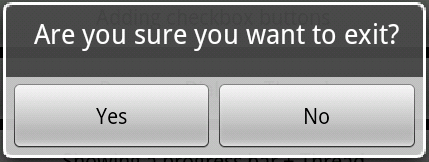새로운 Activity를 띄우지 않고 Windows의 팝업 창처럼 그냥 창을 띄워 상태 알람/진행을 표시하는 녀석이다.
아래 Sample은 각각 종류별로 정리했다. 종류는 아래와 같다.
- Basic Alert - 아주 기본적인 Alert Dialog
- Button add - Dialog 창에 Button이 추가
- List type - 여러가지 항목을 선택
- CheckBox type - CheckBox가 포함
- RadioButton type - RadioButton이 포함(미리 체크 항목을 선택 할 수 있음)
- ProgressDialog type - 동그란 에니메이션이 동작함
- ProgressBar type - 막대 형태로 진행 상태를 표시함
- Custom Dialog - 임의 디자인을 적용
1. Basic Alert

AlertDialog.Builder ab = null;
ab = new AlertDialog.Builder( AlertDialogTest.this );
ab.setMessage( Html.fromHtml("<b><font color=#ff00ff> HTML View</font></b><br>Android.com"));
ab.setPositiveButton(android.R.string.ok, null);
ab.setTitle( "Basic Alert Dialog" );
ab.show();
|
2. Button add

AlertDialog.Builder builder = new AlertDialog.Builder(this);
builder.setMessage("Are you sure you want to exit?")
.setCancelable(false)
.setPositiveButton("Yes", new DialogInterface.OnClickListener() {
public void onClick(DialogInterface dialog, int id) {
Toast.makeText(getApplicationContext(), "ID value is " + Integer.toString(id), Toast.LENGTH_SHORT).show();
}
})
.setNegativeButton("No", new DialogInterface.OnClickListener() {
public void onClick(DialogInterface dialog, int id) {
Toast.makeText(getApplicationContext(), "ID value is " + Integer.toString(id), Toast.LENGTH_SHORT).show();
dialog.cancel();
}
});
AlertDialog alert = builder.create();
alert.show();
|
3. List type

final CharSequence[] items = {"Red", "Green", "Blue"};
AlertDialog.Builder builder = new AlertDialog.Builder(this);
builder.setTitle("Pick a color");
builder.setItems(items, new DialogInterface.OnClickListener() {
public void onClick(DialogInterface dialog, int item) {
Toast.makeText(getApplicationContext(), items[item], Toast.LENGTH_SHORT).show();
}
});
AlertDialog alert = builder.create();
alert.show();
|
4. RadioButtons type

final CharSequence[] items = {"Red", "Green", "Blue"};
AlertDialog.Builder builder = new AlertDialog.Builder(this);
builder.setTitle("Pick a color");
builder.setSingleChoiceItems(items, -1, new DialogInterface.OnClickListener() {
public void onClick(DialogInterface dialog, int item) {
Toast.makeText(getApplicationContext(), items[item], Toast.LENGTH_SHORT).show();
}
});
AlertDialog alert = builder.create();
alert.show();
|
5. Checkboxes type

final CharSequence[] items = {"Red", "Green", "Blue"};
final boolean[] itemsChecked = {false, true, false };
AlertDialog.Builder builder = new AlertDialog.Builder(this);
builder.setTitle("Pick a color");
builder.setMultiChoiceItems( items, itemsChecked, new DialogInterface.OnMultiChoiceClickListener() {
@Override
public void onClick(DialogInterface dialog, int which, boolean isChecked) {
Toast.makeText( getApplicationContext(),
items[which] + " Checked-" + Boolean.toString(isChecked),
Toast.LENGTH_SHORT).show();
}
});
AlertDialog alert = builder.create();
alert.show();
|
6. ProgressDialog type

private class ProgressDialogStop extends Thread
{
private final int mWaitTime = 3000;
private ProgressDialog dialog = null;
public ProgressDialogStop(ProgressDialog dialog) {
// TODO Auto-generated constructor stub
this.dialog = dialog;
}
@Override
public void run() {
int iWait = 0;
try
{
while( iWait < mWaitTime )
{
this.sleep(100);
iWait += 100;
}
}catch(Exception e)
{
//
}
this.dialog.dismiss();
super.run();
}
}
|
ProgressDialog dialog = ProgressDialog.show(AlertDialogTest.this, "",
"Loading. Please wait...", true);
Thread ProgressDialogStopThread = new ProgressDialogStop( dialog );
ProgressDialogStopThread.start();
|
7. ProgressBar type

private class ProgressBarStop extends Thread
{
private final int mWaitTime = 100;
private ProgressDialog progressDialog = null;
public ProgressBarStop(ProgressDialog progressDialog) {
// TODO Auto-generated constructor stub
this.progressDialog = progressDialog;
}
@Override
public void run() {
super.run();
// this.progressDialog.show(); // << 여기서 호출하면 Error 발생한다.
int iWait = 0;
try
{
while( iWait < mWaitTime )
{
this.sleep(100);
iWait++;
Log.i(LOGTAG, Integer.toString(iWait));
progressDialog.setProgress( iWait );
}
}catch(Exception e)
{
Log.i(LOGTAG, e.getMessage());
}
this.progressDialog.dismiss();
}
}
|
ProgressDialog progressDialog = null;
progressDialog = new ProgressDialog( AlertDialogTest.this );
progressDialog.setProgressStyle(ProgressDialog.STYLE_HORIZONTAL);
progressDialog.setMessage("Loading...");
progressDialog.setMax(100);
progressDialog.setCancelable(true);
progressDialog.setButton("Btn1", new DialogInterface.OnClickListener()
{
@Override
public void onClick(DialogInterface dialog, int which)
{
Toast.makeText( getApplicationContext(),
"Btn Click - " + Integer.toString(which),
Toast.LENGTH_SHORT).show();
}
});
progressDialog.setButton2("Btn2", new DialogInterface.OnClickListener()
{
@Override
public void onClick(DialogInterface dialog, int which)
{
Toast.makeText( getApplicationContext(),
"Btn 2 Click - " + Integer.toString(which),
Toast.LENGTH_SHORT).show();
}
});
progressDialog.show();
Thread PrgrsBarStop = new ProgressBarStop( progressDialog );
PrgrsBarStop.start();
|
8. CustomDialog type

별도 Dialog 타입 Layout을 설정해야 한다.
<?xml version="1.0" encoding="utf-8"?>
<LinearLayout
xmlns:android="http://schemas.android.com/apk/res/android"
android:id="@+id/LinearLayout01"
android:layout_height="fill_parent"
android:orientation="vertical"
android:gravity="center"
android:layout_width="200dip">
<TextView
android:id="@+id/TextView01"
android:layout_height="wrap_content"
android:textColor="#fff"
android:textStyle="bold"
android:layout_width="wrap_content"
android:text=" AndroidPeople.com"/>
<TextView
android:id="@+id/TextView02"
android:layout_height="wrap_content"
android:textColor="#fff"
android:layout_width="wrap_content"
android:layout_margin="7dip"
android:text="Custom Dialog Example By AndroidPeople.com"
android:gravity="center"/>
<Button
android:id="@+id/OkButton"
android:layout_width="wrap_content"
android:layout_height="wrap_content"
android:text="OK"
/>
</LinearLayout>
|
import android.app.Dialog;
import android.content.Context;
import android.os.Bundle;
import android.view.View;
import android.widget.Button;
//http://about-android.blogspot.com/2010/02/create-custom-dialog.html
public class MyCustomDialog extends Dialog {
public MyCustomDialog(Context context) {
super(context);
this.setContentView(R.layout.custom_dialog);
}
@Override
protected void onCreate(Bundle savedInstanceState) {
// TODO Auto-generated method stub
super.onCreate(savedInstanceState);
Button btn = (Button)findViewById(R.id.OkButton);
btn.setOnClickListener(new View.OnClickListener() {
@Override
public void onClick(View v) {
dismiss();
}
});
}
}
|
Dialog dialog = new MyCustomDialog(this);
dialog.show();
|
9. CustomDialog type 2
위 8번 내용을 그대로 사용.

AlertDialog.Builder md = new AlertDialog.Builder(this);
LayoutInflater contents = LayoutInflater.from(this);
View customView = contents.inflate(R.layout.custom_dialog, null);
Button btn = (Button)customView.findViewById(R.id.OkButton);
btn.setVisibility(View.INVISIBLE);
md.setPositiveButton("Positive", new DialogInterface.OnClickListener() {
@Override
public void onClick(DialogInterface dialog, int which) {
}
});
md.setNegativeButton("Negative", new DialogInterface.OnClickListener() {
@Override
public void onClick(DialogInterface dialog, int which) {
}
});
md.setNeutralButton("Neutral", new DialogInterface.OnClickListener() {
@Override
public void onClick(DialogInterface dialog, int which) {
}
});
md.setView( customView );
md.show();
|
출처 : http://utime.blog.me/150091024547









